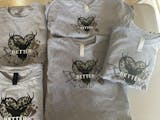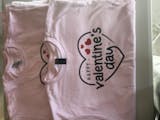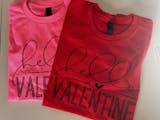In an era where agility and customization reign supreme, I've seen the t-shirt industry transform. At the heart of this revolution is Print-on-Demand (POD), and it's reshaping how small businesses, side hustlers, and t-shirt entrepreneurs approach production and sales. According to a recent forecast, the POD industry is projected to grow at a compound annual growth rate (CAGR) of 26.1% until 2030. This dynamic method is not just a trend; it's a game-changer, offering a new world of possibilities for creativity and business growth.
What is Print-on-Demand?
Print-on-demand (POD) is a digital printing technology that creates individualized t-shirts and other apparel production as needed. It's a system where designs are printed onto products only after an order has been placed, eliminating the need for large inventories and streamlining the manufacturing process. Plus, with print-on-demand services, everything after the sale, from digital printing to order fulfillment and shipping, is handled by a supplier or you can create your own DIY version of printing and fulfillment.
How Does Print-on-Demand Work?
The essence of Print-on-Demand (POD) lies in its order-to-production workflow. Here's how it typically unfolds:
- Order placement: It starts when a customer selects a product and orders. This could be a t-shirt with a custom design, a personalized mug, or any other item offered through a POD service.
- Triggering the printing process: Unlike traditional retail, where products are printed in bulk and stored, POD activates the printing process only after an order is placed. Depending on the chosen product and platform, the design is transferred using one of several print technologies.
- Quality assurance: Each item goes through a quality check following printing to ensure that every product meets a high-quality standard, from the design's clarity to the print's integrity on the fabric.
- Fulfillment and shipping: The product is packed and shipped to the customer after passing the quality check. Fulfillment might be handled by the POD service provider or, in the case of DIY POD setups, by the seller.
This process exemplifies POD's seamless integration of printing, fulfillment, and shipping, enabling businesses to maintain minimal overhead while providing customers with diverse custom-made products.
POD Fulfillment Services vs. POD Marketplaces
Print-on-demand fulfillment services are specialized companies that bring your product designs to life. They house a variety of blank items like t-shirts, mugs, and bags, along with the necessary printing equipment. When an order is placed, these services print the design onto the product, ensuring each item is custom-made per order.
POD marketplaces are platforms where you can license your designs for use on physical products. These marketplaces handle both the promotion and sale of these items. Designers simply upload their artwork and wait for sales, as the marketplace takes care of the rest.
The primary distinction lies in the operational model. Marketplaces produce and sell products, offering a more hands-off approach for designers. Fulfillment services, in contrast, focus solely on manufacturing based on orders they receive, requiring you to handle sales and marketing.
Choosing between these options depends on your resources and business goals. With a fulfillment service, you'll need to establish your own storefront and manage marketing, research, and order processing. This path grants you greater control over marketing and customer service but requires a reliable fulfillment partner. Conversely, marketplaces offer a more passive approach, managing everything from processing to shipping. However, this ease comes with less control over sales and potentially smaller profit margins.
Who is POD Good For?
POD can be useful for a variety of sectors, including:
- Entrepreneurs and side hustlers
- Established brands
- Artists and creators
- Influencers
Print-on-demand can allow for experimentation of market trends and help diversify merchandise and monetize an engaged audience.
Using POD to Your Advantage
POD is more than just a printing method; it's a strategic tool. It allows for testing small batches of diverse products like t-shirts, books, shoes, bags, and more, catering to specific niches or broad markets. Additionally, it's an effective way to test ad creatives. Since there's no upfront cost for goods, you can run ads to determine which designs resonate most, then scale up as demand grows. This adaptability makes POD an excellent choice for anyone looking to enter retail with agility and creative freedom.
The Pros and Cons of POD
Print-on-demand has revolutionized how businesses approach product creation and sales. While it offers numerous benefits, particularly for small businesses and individual creators, it's important to consider both its advantages and limitations.
Pros:
- No upfront investment. Starting a POD business requires minimal initial financial outlay. There's no need for inventory or expensive printing equipment.
- Quick setup. Launching products with your designs is fast and straightforward, allowing you to start selling in just minutes.
- Creative freedom. With POD, you can focus on your creativity without the burden of fulfillment logistics.
- Ease of experimentation. POD makes trying out different designs simple and quickly gauges customer preferences.
- Rapid product creation. Once a design is ready, turning it into a product for sale is a quick process that sometimes takes just minutes.
- Managed shipping and fulfillment. The supplier manages the shipping and fulfillment logistics, leaving you to focus on customer service.
- Low risk. The absence of physical inventory reduces financial risk, making testing new ideas or pivot strategies easier.
Cons:
- Higher cost per item. POD items generally have lower profit margins due to the inclusion of printing, packaging, and staff costs in the price.
- Longer turnaround times. Since products are made after an order is placed, additional processing and fulfillment time can lead to extended delivery periods.
- Reduced profit margins. The per-item cost is higher with POD than bulk purchases, affecting overall profit margins.
- Limited control over shipping. Shipping costs can be complex and variable, with fewer options for creating a unique unboxing experience.
- Product limitations. The range of products and customization options depends on the chosen vendor, requiring careful consideration of costs and features.
Setting up a DIY POD Business
An alternative approach to mitigate some of the cons associated with traditional POD services is establishing a DIY Print-on-Demand system. You can create a fulfillment center right in your home or office by ordering pre-printed DTF transfers from a supplier like We Print U Press.
This method offers several distinct advantages:
- Enhanced quality control: Handling the printing process yourself allows for greater oversight of the final product quality.
- Expanded product lines: You're not limited by the offerings of a POD vendor. With your own system, you can experiment with a broader range of products. We Print U Press has an extensive library of transfer designs for all occasions or you can upload your own custom artwork to be printed as custom DTF transfers.
- Ownership of customer data: Direct customer interaction enables you to collect and utilize customer data for marketing and sales strategies.
- Personalized customer service: Being in charge of the entire process allows for more personalized and responsive customer service.
- Maximized margins and profit: By eliminating the middleman, you can increase your profit margins.
However, this approach does come with its own set of challenges:
- Increased responsibility: Managing all aspects of production, fulfillment, and customer service can be time-consuming and requires diverse skills.
- Initial investment: Setting up a DIY POD system involves some upfront costs for equipment and materials, like a heat press, shipping scales and shipping label printers.
- Space requirements: You'll need space for shipping and storage.
Adopting a DIY POD system offers a hands-on approach to business, giving you complete control over every aspect of the enterprise but requiring a significant commitment in time, effort, and resources.
POD Printing Methods
The Print-on-Demand industry employs several printing technologies, each with unique attributes and best use cases. Understanding these methods is crucial for businesses and creators leveraging POD for their products. Each method offers distinct advantages and challenges. Here is a brief overview of the top four methods for POD.
DTG (Direct-to-Garment) Printing:
Direct-to-garment printing is a well-established method in the POD landscape. It involves printing the design directly onto the fabric using inkjet technology. The key strengths of DTG are its ability to produce full-color blends and gradients with a relatively soft hand feel and a natural look. However, DTG has its downsides:
- Texture and graininess: Some designs may exhibit a slight texture, inconsistency, or graininess.
- Durability issues: DTG prints are notorious for breaking down after multiple washes, affecting the overall appearance and print quality.
- Fabric suitability: DTG works best on cotton fabrics. It's not recommended for synthetic materials or blends, limiting its versatility for those offering a wide range of products and fabric types.
Despite these limitations, DTG remains popular for its ease of use and quality output, especially for designs requiring detailed color work.
DTF (Direct-to-Film) Transfers:
Direct-to-film printing is a newer, emerging technology in the POD sphere. DTF involves printing a design onto a special film, which is then transferred onto the fabric using a heat press. This method has rapidly gained popularity due to several advantages:
- Durability: DTF prints are known for their durability and resistance to wear and tear.
- Detail and color vibrancy: DTF excels in producing highly detailed and vibrant prints, making it suitable for complex designs.
- Fabric compatibility: Unlike DTG, DTF isn't restricted to cotton and works effectively across various fabrics, including synthetics and blends.
- Setup for home businesses: An attractive aspect of DTF is the ability to order pre-printed transfers. This feature allows entrepreneurs to set up a POD business from home with minimal equipment – primarily a heat press and basic supplies.
DTF transfers’ versatile and robust nature positions it as a promising option in the POD industry, especially for those seeking to blend quality, durability, and fabric versatility in their products.
Screen Print Transfers:
Screen print transfers represent a traditional approach adapted for modern POD needs. This method involves printing designs onto transfer paper using plastisol inks and applied to the fabric through a heat press. This method has been embraced for several reasons:
- Durability: Screen print transfer prints are long-lasting (similar to traditional screen prints), making them ideal for designs that need to endure.
- Color options and special effects: They allow for a wide range of spot colors, including Pantone matching and special FX inks, offering significant creative flexibility.
- Bulk discounts: Ordering in bulk can lead to significant cost savings, making it a viable option for larger orders.
However, screen print transfers have certain limitations:
- Cost increases with colors: The more colors involved in a design, the higher the production cost, as each color requires a separate screen.
- Challenges with details and gradients: This method can struggle with intricate details and smooth gradients, limiting design complexity.
- Fabric restrictions: Like DTG, screen print transfers have limitations on the types of fabrics they work best with.
It's important to note that screen print transfers are mainly viable for DIY POD setups, as most POD services do not offer this option. This method suits those who wish to combine the traditional quality of screen printing with the flexibility of POD.
Sublimation and Cut-and-Sew:
Sublimation printing and the cut-and-sew method represent the more specialized and upscale approaches in the POD market, catering primarily to fashion brands and high-end products.
Sublimation printing involves transferring a design onto fabric using heat-sensitive inks. It's particularly effective for all-over prints and vibrant, full-color images. Sublimation works best on high count polyester and polymer-coated substrates, allowing for a range of creative and visually striking products. However, it's a more cost-intensive process for specific product types, like sportswear and promotional items.
Cut-and-sew involves printing the design onto fabric before sewn into the final product. This method offers unparalleled design flexibility, allowing for edge-to-edge printing with no constraints on the layout. It's ideal for creating unique, custom garments and products that stand out in the market. However, it requires more specialized printing and garment construction skills and the costs are higher than those of other POD methods.
Both sublimation and cut-and-sew are excellent choices for businesses looking to offer premium, highly customized products, but they demand more significant investment in time, resources, and expertise.
The Booming POD Market
The Print-on-Demand market is experiencing rapid growth and evolution, driven by technological advancements and changing consumer preferences. This expansion presents unique opportunities for businesses seeking to join or grow an existing brand.
Global Reach and Expanding Customer Base:
- Worldwide access: POD offers unparalleled access to global markets, enabling brands to reach diverse customer bases across different regions.
- Customization appeal: The demand for custom and personalized products is rising, with consumers seeking unique items that reflect their individuality.
- Influencer and community designs: Influencer marketing and community-driven designs are increasingly popular, tapping into dedicated followers and niche audiences.
Sustainable Growth and Future Trends:
- Market growth: The POD industry is set to expand at a compound annual growth rate (CAGR) of 26.1% until 2030.
- Eco-friendly options: There's a growing demand for sustainable and environmentally conscious POD products and practices.
- Technological advancements: New technologies are constantly emerging, such as heat transfer patches, promising to expand further and refine the capabilities of POD.
Standing Out in a Competitive Market:
- Niche targeting: Success in the crowded POD market often involves identifying and catering to specific niches utilizing targeted marketing strategies and promotions.
- Investing in what works: The unique power of POD to test a variety of designs and products lowers risk and allows for smart investment and greater ROI.
- Utilizing online platforms: Leveraging existing online marketplaces and selling platforms can significantly broaden a brand's reach, complementing self-hosted e-commerce efforts.
Print Your Way to Success with POD
As I've explored, print-on-demand offers a unique blend of flexibility, creativity, and market accessibility that transforms how businesses and entrepreneurs approach product creation and sales. From the ability to start with minimal upfront investment to the freedom to experiment with designs and reach global markets, POD empowers individuals and businesses alike to tailor their approach to meet customer demands.
For customers, POD brings the joy of customization and the value of unique, personalized products. It's a win-win scenario where businesses can rapidly respond to market trends and customer preferences. At the same time, consumers enjoy a diverse range of products that resonate with their personal style and interests. We would love to become your DTF transfer supplier and if you don't have a heat press, we can even make the shirts for you! Just add our Press on Demand service to your order for each shirt.
Whether you're an established brand looking to expand your product line, an artist seeking to monetize your creativity, or a side hustler aiming to test the entrepreneurial waters, POD is ripe with opportunities. If you're just getting started, make sure to read our Finding Your Niche: A Guide to Success. I invite you to enter this dynamic and evolving market with We Print U Press as your apparel POD service. Let us help you print your way to success!.
Conclusion
To summarize, POD is a game-changer for the t-shirt and apparel industry that is growing rapidly. I encourage further research to learn more about the possibilities of POD.








